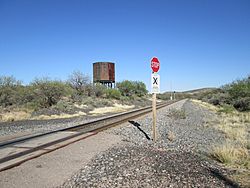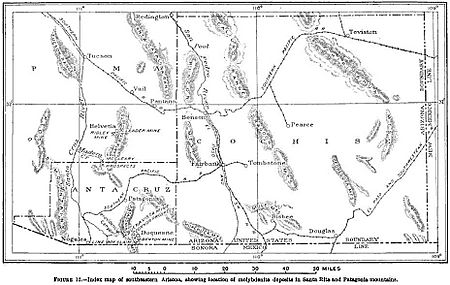Pantano, Arizona facts for kids
Quick facts for kids
Pantano, Arizona
|
|
|---|---|

The railroad crossing and water tower in Pantano.
|
|
| Country | United States |
| State | Arizona |
| County | Pima |
| Elevation | 3,553 ft (1,083 m) |
| Population
(1922)
|
|
| • Total | ~500 |
| Time zone | Mountain (MST) |
| Post office opened | July 2, 1880 |
| Post office closed | 1952 |

Pantano is a ghost town in eastern Pima County, Arizona. It's located between the towns of Benson and Vail. You can reach it from the Marsh Station Road exit on I-10. Pantano started as a small railroad town in 1880. This happened when the Southern Pacific railroad arrived. It took the place of an older station called Ciénega, which was a bit further west.
Contents
History of Pantano
Early Days and Challenges
The area where Pantano is located has a long history. An earlier station, Ciénega Station, was set up here in 1858. This was done by the Butterfield Overland Mail company. The station and later town had many names over the years. These included Pantano Station, Marsh Station, Tulleyville, and Empire. It was even built on the site of an old Hohokam village.
In the early days, conflicts with Apache people were a constant problem. In 1861, the wife of Granville Henderson Oury traveled through the area. She wrote about how dangerous it was. She worried about attacks from Apache groups.
Attacks and the Cemetery
One morning in 1867, an early settler named W. A. "Shotgun" Smith and three friends were attacked. This happened at the station. All three of his friends were killed. Smith, using his shotgun, managed to fight off the attackers.
Edward Vail, who owned the nearby Vail Ranch, shared a sad fact. He said the Pantano Cemetery is "filled with graves of men killed by Indians." This shows how tough life was back then.
The Railroad Arrives
The Pantano railroad station and the town of Pantano were officially started in 1880. This was when the Southern Pacific railroad came to Pima County. They began building tracks along the south side of Ciénega Creek. The town's first location was chosen because it was good for building a depot. A depot is a train station and storage area.
The new location also attracted businesses and settlers. They built several warehouses and homes. There was a small store with a blacksmith shop. A carpenter's shop was also built. In 1880, about 75 people lived in Pantano.
Moving the Town
In 1887, severe flooding hit the area. This forced the town to move. Residents rebuilt Pantano on the northern side of the creek. This new location was safer from floods.
Growth and Decline
By 1905, Pantano's population grew to 100 people. The town had a deputy sheriff and a justice of the peace. There were also six small businesses. These included a general store and a livery (where horses were kept).
Pantano reached its peak in 1922. About 500 people lived there. The town had a bank and a schoolhouse. It also had a telegraph office and a post office. But soon after, the Great Depression began. This was a time when the economy was very bad. The town started to shrink. By 1941, only 40 people were left.
The post office closed in 1952. Railroad operations stopped by 1956. This left the town abandoned. In the 1960s, the Southern Pacific railroad tore down most of the buildings.
Pantano Today
Today, Pantano is a true ghost town. The Pantano Townsite Conservation Area was created in 2004. This area is mostly within the Ciénega Creek Natural Preserve. Its goal is to protect the townsite and its history.
All that remains now are a few building foundations. You can also see a water tower and pumphouse. These were built by the railroad. The old cemetery is still there too.
Jimmie Mercer Memorial
On December 2, 1914, a Pima County Ranger named Jimmie Mercer was shot. He and a rancher named Robert Fenton were approaching a ranch north of Pantano. A Mexican cattle rustler named J. Padilla fired at them. Mercer was hit in the leg. The gunman then escaped.
Mercer was taken back to Pantano. From there, he got on a train to Tucson. He sadly died about a week later, on December 10, 1914. Today, there is a small memorial for him. It is near Pantano, at the entrance to the Ciénega Creek Natural Preserve.
Gallery









